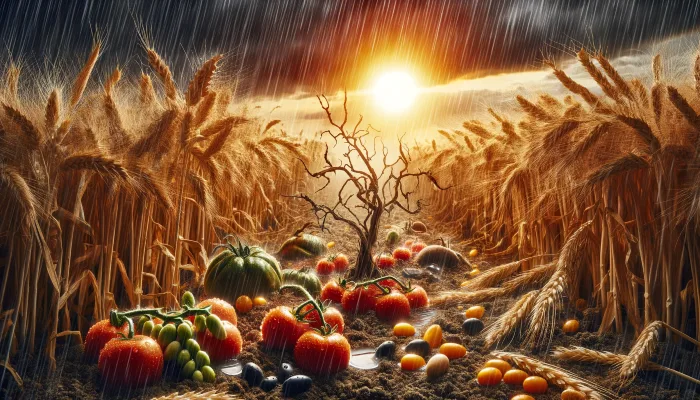Last year, farmers around the world faced the harsh realities of climate change. Extreme weather, like violent storms, floods, unexpected freezes, scorching heatwaves, and relentless droughts, wreaked havoc on agriculture. In 2023, we saw the direct consequences: tomato plants failed to bloom, peach harvests were nonexistent, and olive oil prices skyrocketed.
Being involved in agriculture today, whether as a farmer, an agronomist, or an agricultural economist, means recognizing the direct link between these erratic weather events and climate change. This connection was so evident that the United Nations Climate Change Summit (COP28) in Dubai included a pact with 134 countries. They agreed to consider sustainable agriculture in their climate plans.
The Alarming Threat to Global Food Security
As we look to 2024, the challenges for the agriculture sector are monumental. Crop scientists are racing against time and unpredictable weather, trying to develop new growing methods and plant varieties.
But as James Schnable, a plant geneticist at the University of Nebraska-Lincoln, points out, “Plant breeding is a slow process. It takes seven to 10 years to develop and release a new corn variety.”
The ever-changing climate, water shortages, policy shifts, and fluctuating commodity prices make predicting future agricultural needs incredibly difficult.

The fear that climate change will outpace agricultural advances isn’t unfounded. Back in 2019, the Global Commission on Adaptation warned that climate change could slash farming yields by up to 30% by 2050. This drastic reduction would hit the world’s 500 million small farmers the hardest. Additionally, research has shown that since the 1960s, unexpected drops in food production have been increasing each year. Even more alarming, extreme heatwaves, which were rare just a decade ago, are now becoming a regular occurrence across various regions of the globe.
Facing the Fury of Climate Change: 13 Foods Likely To Be Hit The Hardest
Climate change is reshaping agriculture globally, and our food supply is feeling the impact. Here’s a listicle of foods that are increasingly threatened by climate change, along with some additional items at risk, backed by real data and statistics:
- Tomatoes – In 2023, the UK and Ireland faced tomato shortages due to extended cold weather in Spain and Morocco. India saw tomato prices surge by 400% following crop failures.
- Peaches – Unseasonal weather patterns have led to failed peach crops in various regions, impacting both availability and prices.
- Olives – Spain, a world leader in olive oil production, reported below-normal harvests two years in a row. This has led to a significant increase in olive oil prices.
- Potatoes – In Northern Ireland, dry weather reduced the potato harvest by 4.4 million pounds in 2023. This is an alarming trend for a staple food.
- Corn – In India, heavy rains hindered the corn harvest, affecting livestock feed and raising concerns about food security.
- Blueberries – Peru, the world’s leading blueberry exporter, reported that its crop would be half its normal size, indicating the severity of climate impacts on fruit cultivation.
- Wine Grapes – Wine production in Europe, Australia, and South America dropped to its lowest since 1961, showing the vulnerability of this crop to climate extremes.
- Coffee – Rising temperatures and unpredictable rainfall patterns are threatening coffee production, particularly in countries like Brazil, Vietnam, and Colombia.
- Chocolate – Cocoa, the key ingredient in chocolate, is facing threats from changing weather patterns in West Africa, which produces over 70% of the world’s cocoa.
- Rice – As a staple for half the world’s population, rice is at risk due to sea level rise, salinity, and changing monsoon patterns, particularly in Asia.
- Wheat – Essential for bread, pasta, and more, wheat is being affected by heatwaves and droughts, reducing yields and quality.
- Bananas – Climate change is exacerbating fungal diseases like Panama disease, threatening banana plantations globally.
- Apples – Erratic weather patterns are affecting apple harvests, with impacts on both quantity and quality of this popular fruit.
Statistics and Predictions
More To Discover
- The Global Commission on Adaptation predicted a reduction of farming yields by up to 30% by 2050 due to climate change.
- Research shows that food production shocks have increased yearly since the 1960s.
- The USDA’s updated “plant hardiness zone” map indicates warming of up to 5 degrees Fahrenheit in about half of the USA.
The Way Forward
With these challenges, the importance of agricultural innovation and adaptation becomes clear. James Schnable, a plant geneticist, emphasizes that plant breeding is slow, and adapting to future environmental conditions is complex. The need for global cooperation and sustainable practices in agriculture is more critical than ever to protect our food supply and support the 500 million small farmers worldwide who are most vulnerable to these changes.



















